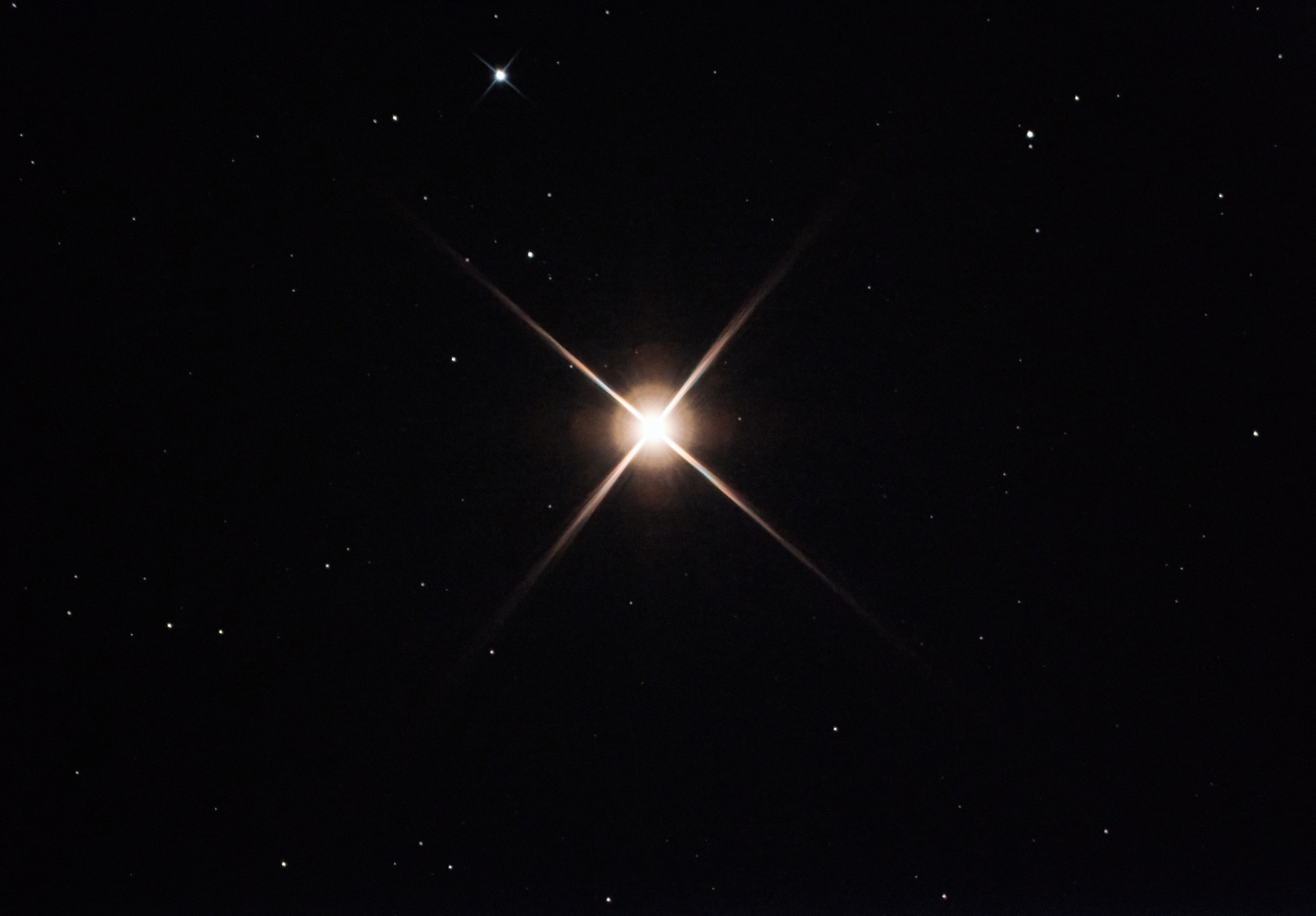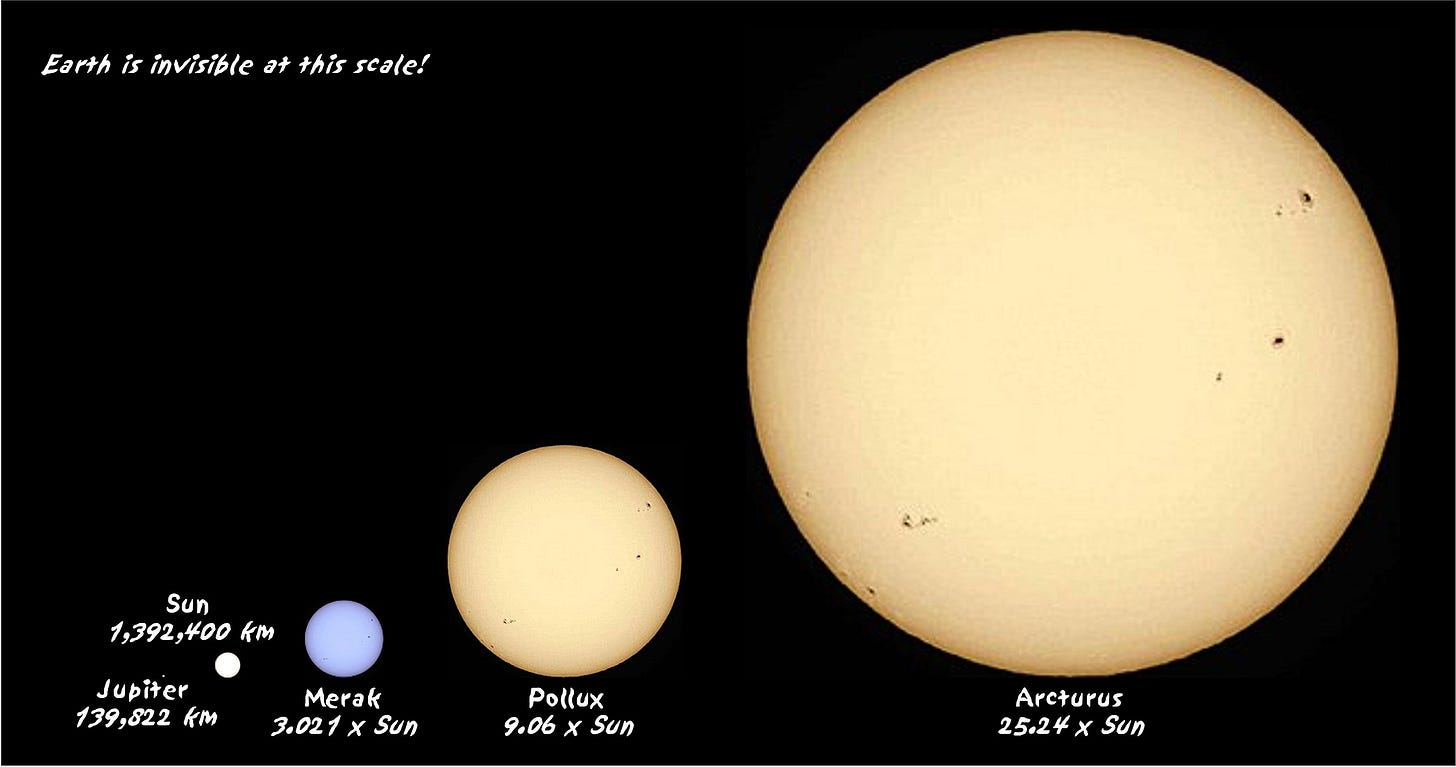Arcturus - A Star on the Move
The Fourth-Brightest Star Gives Us a Preview of Our Solar System's Future

Much of this spring brought cloud and blustery winds along with much-needed rain, so I contented myself with watching wildflowers bloom and peering through a telescope to watch northern flickers and bohemian waxwings get about their business. On a few nights, starlight streamed through “sucker holes”, transitory gaps in thick clouds that tempt stargazers to spend time setting up a telescope before snapping shut. I didn’t take the bait, but I paused from time to time to catch a glimpse high in the northeast of yellow-orange Arcturus, a brilliant star that’s a reliable herald of northern spring and as welcome as the face of a friend in a hostile crowd.
Arcturus ranks as the fourth brightest star in the sky and the brightest north of the celestial equator. It takes its name from the ancient Greek arktos (‘bear watcher’). The star lies directly south of Ursa Major, the Great Bear and its embedded Big Dipper asterism. Novice stargazers learn to find Arcturus by following the arc of the Dipper’s handle away from its bowl with the famous ditty:
“Follow the arc to Arcturus,
And on to Spica go;
Then turn northwest to Regulus, the foot of the Lion, Leo
Together Arcturus, Spica, and Regulus form the Spring Triangle and serve as the brightest stars in an otherwise sparse spring sky.
Arcturus and its host constellation Boötes has long figured in cultures and legends across the world. In the Odyssey, Homer writes of Odysseus sailing his ship away from the land of Ogygia where he was held captive for seven years and tells of him:
“...taking his seat artfully with the steering oar he held her
on her course, nor did sleep ever descend on his eyelids
as he kept his eye on the Pleiades and late-setting Boötes,
and the Bear, to whom men give also the name of the Wagon,
who turns about in a fixed place and looks at Orion,
and she alone is never plunged in the wash of the Ocean.”
Polynesian navigators called the star Hōkūleʻa, the "star of joy" and used it to sail their double-hulled canoes thousands of miles from Tahiti and the Marquesas Islands northwards. They followed the Pleiades and the star Aldebaran eastward, then turned north to cross the equator until Arcturus was overhead, and finally followed trade winds to sail west. By maintaining a heading that kept Arcturus at the zenith at its highest point in the sky each night they eventually arrived at the Big Island of Hawai’i. For the return trip, they made their way back southward by following the winds and currents until Sirius, the zenith star of Tahiti, lay overhead.
Arcturus also dazzled visitors to the 1933 Century of Progress International Exposition in Chicago, more simply known as the 1933 World’s Fair. Astronomers of the day placed the star at a distance of 40 light years which meant its light left 40 years earlier during the last World’s Fair held in Chicago in 1893. So they devised a scheme to collect the star’s light with a telescope, convert it to electricity using photocells, then amplify and transmit the signal hundreds of miles through telegraph lines to switch on a powerful spotlight on the Hall of Science on opening night. It worked. On May 27, a crowd of 30,000 cheered by the Lake Michigan shoreline as the fairground was illuminated with the help of Arcturus while they glanced up to see the star itself beaming in the warm spring sky. The 1933 fair was a success with many spectacular demonstrations of advancements in science, technology, and architecture that offered a more promising future during the dark days of the Great Depression.
A Preview of Our Solar System’s Future
More precise measurements place Arcturus at a relatively nearby distance of 36.7 light years, and the star offers a study in contrast with our own sun. Arcturus is only about 10% more massive than our sun, and it possesses a magnetic field that varies over 14 years to the sun’s 11-year cycle. It has spectrum rich with signatures of elements such as iron, sodium, and calcium, but at abundances only a third that of the sun. Arcturus rotates slowly, once every two years, to our star’s 26-day rotational period. At 4,300K, the star’s outer atmosphere is cooler the sun’s 5,700K temperature. Most importantly, Arcturus has an age of about 7 billion years, more than 2.5 billion years older than the sun, and so offers astronomers a close-up view of our solar system’s future.

When it was contented middle-aged star and burning hydrogen in its core, Arcturus shone only modestly brighter than our sun. But the star has since entirely consumed its allotment of hydrogen and, without an energy source to push back, endured the iron hand of gravity squeezing its central region until it grew hot enough to burn hydrogen in a shell around an inert helium core. The fierce energy from the hydrogen burning shell ballooned out the star’s rarefied outer layers to some 25 solar diameters and increased its brightness to more than 170 suns. As they expanded, the outer layers cooled to a temperature of about 4,300 K which gives the star a tangerine hue that’s the signature of a mid-sized red giant star. The visible layers of the yellow-white sun have a temperature of about 5,700K.
As shell burning continues in a red giant like Arcturus, more inert helium ash collects in the core which increases its mass and density until electrons get packed tight enough to experience quantum mechanical effects that resolutely push back against the star’s crushing outer layers. Physicists call matter degenerate, a term that refers not to any moral failing on the part of the electrons but rather to a state that behaves entirely differently from a gas. As heat is added to a normal gas in a star’s core, it expands and cools - a built-in self-correcting mechanism. But in a degenerate state, the star’s core simply grows hotter without expanding, more like a liquid than a gas. When the degenerate helium-rich core reaches 100 million Kelvin, it begins to burn helium into carbon nuclei through nuclear fusion. This creates more heat, which further increases the rate of nuclear fusion, which releases even more heat in a runaway effect known as the helium flash. For this brief phase of a star’s life, half an Earth mass of helium ignites in just a few minutes and releases a staggering amount of energy, perhaps as much as all the stars in the entire Milky Way. It sounds violent and spectacular, but outside observers see very little, if anything, of the helium flash. Most of its energy goes into undoing the work of gravity by expanding the star’s dense and massive core out of a state of electron degeneracy and back into a hot and dense non-degenerate gas.
Because the precise mass of Arcturus is uncertain, astronomers still debate whether it has endured its helium flash. But when a star does so, it shrinks and dims considerably compared to its red giant phase and continues for the next 100 million years to fuse helium into carbon in the core and hydrogen to helium in a shell around the core. When the helium runs out in the core, the game is up. The star isn’t sufficiently massive to squeeze the core hot enough to fuse carbon into heavier elements. Instead endures a series of coughs and sputters over tens of millions of years as it casts off its outer layers as an immense and rarified planetary nebula. The scorching-hot carbon core remains as a hot stellar cinder called a white dwarf.
Arcturus, it appears, has no major planets to endure its erratic and menacing red giant phase, possibly because it formed at a time and place when fewer heavier elements were present in its birth cloud. But when the sun expands into a red giant like Arcturus in half a billion years, plenty of mayhem will ensue. Its tenuous outer layers will surely incinerate Mercury and Venus. Earth oceans, atmosphere, and possibly its outer crust will boil away leaving only an iron-rich core. As the sun loses mass during its final stages, the Earth’s remnants and the outer planets will shift into more distant orbits around a burnt-out stellar core where they will remain orbiting, sterile and forlorn, for tens of billions of years.
A Star on the Move
Whatever its eventual fate, Arcturus emerged from its birthplace when the universe was half its present age and it appears to have endured a long journey to arrive in our celestial neighborhood. The star shares a common motion through the galaxy - but not a sibling-like chemical composition - with a group of 52 of stars known as the Arcturus Stream that were perhaps once part of a much smaller galaxy ingested by the Milky Way billions of years ago. Other members of the stream are scattered around the sky and some are visible to the unaided eye including 27 Cancri and Anser in the constellation Vulpecula. These stars inhabit the so-called thick disk of the galaxy, a collection of older stars that bob up and down within 4,000 light years of the plane of the Milky Way’s 100,000 light-year-wide disk. By contrast, most freshly-born stars occupy the thin disk that extends just a few hundred light years above and below the galactic plane. The origin of the thick disk is an active area of research for astronomers who are trying to determine whether its ancient stars came from the accretion of dozens of smaller galaxies into the Milky Way or if they arose from internal dynamical processes.
Befitting a star that’s come a long way, Arcturus is surely a star on the move. It’s presently moving towards our solar system at a speed of 121 km/s and will reach its closest point in about 4,000 years before speeding away. In half a million years, Arcturus will lie far enough to fade from visibility to the unaided eye.
This rapid motion across the sky eventually captured the attention of astronomers. Edmund Halley noted in 1717 that Arcturus’ position changed appreciably compared to that noted by Ptolemy and Hipparchus some 1,800 years earlier. Halley concluded, as did Jacques Cassini more convincingly a few years later, that his ancient predecessors couldn’t have made such a conspicuous error. Arcturus moved, a direct refutation of Aristotle’s declaration that the heavens are fixed and unchanging. Astronomers call this type of movement perpendicular to our line of sight proper motion. Most nearby stars exhibit such motion to some degree. More precise measurements show Arcturus moves southward at about 2.3”/year, which works out to about 3 arc-minutes, a tenth the diameter of the full Moon, in an average human lifetime. Most stars have smaller proper motions, but all stars move, and measurements from the amazingly productive GAIA space observatory show the evolution of the position and motion of more than a billion stars in our part of the Milky Way galaxy as shown in this video:
Like most stars, even bright ones, Arcturus presents little detail in a backyard telescope. But it’s always worth a look. At the end of a spring night when I’m out hunting galaxies and globular clusters, I’ll swing the scope towards the star to take a long look through the eyepiece at its shimmering disk in the cold early-morning air. Before heading inside to catch a few hours of sleep, I’ll leave the scope aligned to the celestial sphere and return to the eyepiece in mid-morning to see Arcturus low in the west, glittering like a glass shard in the bright blue morning sky, a well-traveled beacon some half the age of the universe pulled into our neighborhood by the gravitational vicissitudes of the Milky Way.



